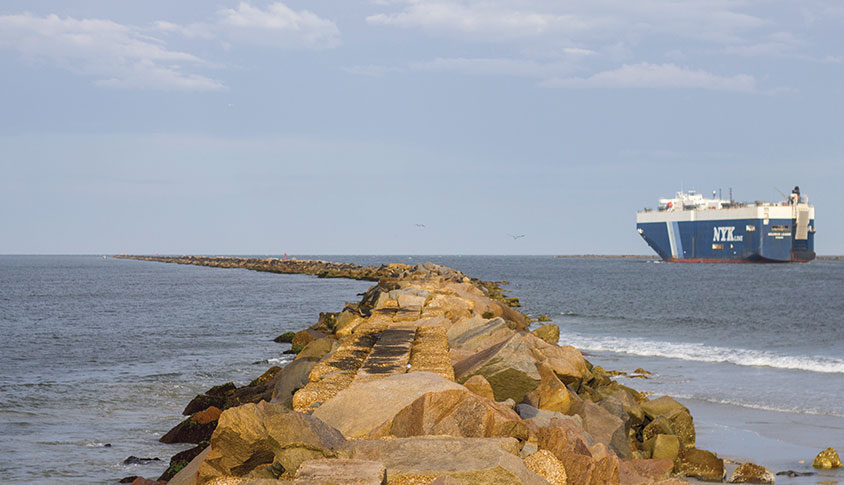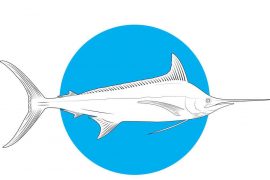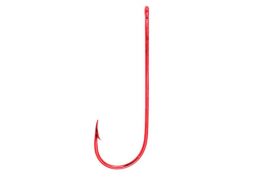Visit Historic Mayport and Battle the Largest Redfish of Your Life
The St. Johns River inlet in Mayport, FL is a deep water pass located on the outskirts of Jacksonville that has long been used for the transit of commercial and naval vessels. Locals refer to this busy maritime thoroughfare as Mayport Inlet, but what you or anyone else calls it doesn’t matter to the numerous cargo-freighters, cruise ships, vehicle carriers and naval ships entering and exiting the wide channel each and every day. The only thing that really matters to fishermen is that this bustling passageway connecting the St. Johns River to the open Atlantic Ocean is ground zero for monster bull redfish.

Believe me when I tell you Mayport Inlet is the place to go for ridiculously large redfish. I’m not talking about 28- to 30-inch fish just exceeding the top of the slot. Rather, this deep inlet is home to hefty 20 to 40 pound bruisers, with some true giants approaching the coveted 50-pound mark in the mix. Where else in Florida can you find big numbers of quality redfish like this? These prehistoric looking beasts have giant heads and broad shoulders with massive girths rivaling that of a Jacksonville Jaguars linebacker. The biggest of the bunch are covered in huge scales and look like they’ve been ruling the near coastal depths for longer than you and I have been alive.
As long as you’re properly prepared, rigged correctly and position your boat accordingly, you should have no trouble scoring the largest redfish of your life.
While you can connect with redfish in Mayport Inlet any day of the year, each fall massive schools of titanic drum visit the pass during their annual migration. The giant fish patrol these coffee colored waters to gorge on abundant forage delivered in the way of thick pogy schools. Few other food sources attract and sustain such impressive numbers of hungry, breeding-sized drum. The oily, nutrient-rich baitfish are so thick that with only one or two well-executed throws of a net it’s easy to load up on a full day’s supply.
Also worth mentioning is that unlike many fisheries where scoring the largest, most mature fish of any species is nearly an impossible task, for local and visiting anglers catching monster drum in Mayport Inlet couldn’t be much easier. As long as you’re properly prepared, rigged correctly and position your boat accordingly, you should have no trouble scoring the largest redfish of your life.
While there are numerous launch points along the St. Johns River, the most convenient access to inlet hot spots is provided to those who launch at the Mayport Boat Ramp at the end of Highway A1A. With ample parking ultra-wide ramps with adjacent floating docks, everything s in excellent condition and the ramps are barely a mile to the mouth of the cut, so brief boat rides to and from prime fishing grounds are the norm.
Since you’ll be fishing in upwards of 80 feet of water inside this deep inlet, there are a few things you will need prior to departing. One of the most important is a reliable anchor with ample ground tackle. I recommend a Fortress F-23 with 10 feet of chain and 300 feet of rode. This is an ideal set up when dropping the hook just outside the channel, inside of the inlet, parallel to either of the two jet-ties. You should also carry a grapple anchor to throw when staging near the end of the jetties where the boulders protrude under the surface, or when the correct combination of wind and tide allow you to throw the hook into the rocks. Just remember to never risk your safety and never anchor directly in the navigable channel. Your fiberglass boat will not come out on top against a 50,000-ton steel freighter entering or exiting the pass. These massive ships can’t stop or maneuver in tight quarters, so always lean on the side of caution. No fish is worth your life.
Regarding bait, unless conditions are way off, you’ll notice concentrated pogy schools inside the inlet, just outside the mouth of the inlet, and both to the north and south of the jetties bordering this fish-attracting haven. Look for diving birds during either tide to lead the way to the bait schools. Additionally, those in the know leave the dock with an ample supply of blue crabs. After removing the claws and carapace, the irresistible crustaceans can be fished whole or cut in half. With either offering— live pogy or cut crab—the approach is the same and relatively simple.
Start with a set of 7’0” or 8’0” conventional rods rated for 20 to 40 lb. line with matching reels loaded with 40 or 50 lb. braid, and don’t skip the 50 lb. test mono top-shot. This class of tackle may sound like overkill when mentioned in the same sentence with redfish, but when you’re dealing with 60 to 80 feet of water and heavy sinkers, big baits and raging cur-rents, this level of equipment is essential for besting trophy class fish as quickly as possible. Mayport’s monster reds are all breeders that must be released unharmed in oder to ensure the continued health of this valuable fishery. Prolonged battles on lighter gear could spell disaster for exhausted females.
As for terminal tackle, a single hook rig on 50 lb. leader with a 12 oz. bank sinker and the bait presented just off the bot-tom via an 18-inch branch line is the way to go. The VMC 7/0 in-line tournament circle-hook does an excellent job of finding a solid home in the corner of the mouth without risking injury to the precious fish.
Because redfish are constantly moving in and out of the pass, just about anywhere you set up alongside the interior of the jetties will put you in the zone, but there are certainly optimal plateaus and ledges that regularly concentrate fish. By spending some time investigating both sides of the channel while keeping one eye glued to the sounder you’ll be able to easily identify these likely honey holes. You should also key in on “blow outs” in the jetties where large spaces be-tween rocks allow vast amounts of water to rush in and out of the inlet.
Once in position, deploy three or four baits directly to the bottom, lock up and start humming your favorite tune. Now it’s just a matter of time before a fat red sniffs out the crunchy treat or frantic pogy. Strikes may be violent but also subtle, so keep eyes glued to the rod tips for signs of life. And if you’re not rewarded for your efforts within 30 to 60 minutes, retrieve the anchor and reposition. Sometimes all it takes is a little wiggle to turn things around.
As a final reminder, handle these big, beautiful fish with great care. If you are going to remove them from the water for photo opportunities, do so quickly and always support the fish horizontally.
Visit Historic Mayport and Battle the Largest Redfish of Your Life
The St. Johns River inlet in Mayport, FL is a deep water pass located on the outskirts of Jacksonville that has long been used for the transit of commercial and naval vessels. Locals refer to this busy maritime thoroughfare as Mayport Inlet, but what you or anyone else calls it doesn’t matter to the numerous cargo-freighters, cruise ships, vehicle carriers and naval ships entering and exiting the wide channel each and every day. The only thing that really matters to fishermen is that this bustling passageway connecting the St. Johns River to the open Atlantic Ocean is ground zero for monster bull redfish.

Believe me when I tell you Mayport Inlet is the place to go for ridiculously large redfish. I’m not talking about 28- to 30-inch fish just exceeding the top of the slot. Rather, this deep inlet is home to hefty 20 to 40 pound bruisers, with some true giants approaching the coveted 50-pound mark in the mix. Where else in Florida can you find big numbers of quality redfish like this? These prehistoric looking beasts have giant heads and broad shoulders with massive girths rivaling that of a Jacksonville Jaguars linebacker. The biggest of the bunch are covered in huge scales and look like they’ve been ruling the near coastal depths for longer than you and I have been alive.
As long as you’re properly prepared, rigged correctly and position your boat accordingly, you should have no trouble scoring the largest redfish of your life.
While you can connect with redfish in Mayport Inlet any day of the year, each fall massive schools of titanic drum visit the pass during their annual migration. The giant fish patrol these coffee colored waters to gorge on abundant forage delivered in the way of thick pogy schools. Few other food sources attract and sustain such impressive numbers of hungry, breeding-sized drum. The oily, nutrient-rich baitfish are so thick that with only one or two well-executed throws of a net it’s easy to load up on a full day’s supply.
Also worth mentioning is that unlike many fisheries where scoring the largest, most mature fish of any species is nearly an impossible task, for local and visiting anglers catching monster drum in Mayport Inlet couldn’t be much easier. As long as you’re properly prepared, rigged correctly and position your boat accordingly, you should have no trouble scoring the largest redfish of your life.
While there are numerous launch points along the St. Johns River, the most convenient access to inlet hot spots is provided to those who launch at the Mayport Boat Ramp at the end of Highway A1A. With ample parking ultra-wide ramps with adjacent floating docks, everything s in excellent condition and the ramps are barely a mile to the mouth of the cut, so brief boat rides to and from prime fishing grounds are the norm.
Since you’ll be fishing in upwards of 80 feet of water inside this deep inlet, there are a few things you will need prior to departing. One of the most important is a reliable anchor with ample ground tackle. I recommend a Fortress F-23 with 10 feet of chain and 300 feet of rode. This is an ideal set up when dropping the hook just outside the channel, inside of the inlet, parallel to either of the two jet-ties. You should also carry a grapple anchor to throw when staging near the end of the jetties where the boulders protrude under the surface, or when the correct combination of wind and tide allow you to throw the hook into the rocks. Just remember to never risk your safety and never anchor directly in the navigable channel. Your fiberglass boat will not come out on top against a 50,000-ton steel freighter entering or exiting the pass. These massive ships can’t stop or maneuver in tight quarters, so always lean on the side of caution. No fish is worth your life.
Regarding bait, unless conditions are way off, you’ll notice concentrated pogy schools inside the inlet, just outside the mouth of the inlet, and both to the north and south of the jetties bordering this fish-attracting haven. Look for diving birds during either tide to lead the way to the bait schools. Additionally, those in the know leave the dock with an ample supply of blue crabs. After removing the claws and carapace, the irresistible crustaceans can be fished whole or cut in half. With either offering— live pogy or cut crab—the approach is the same and relatively simple.
Start with a set of 7’0” or 8’0” conventional rods rated for 20 to 40 lb. line with matching reels loaded with 40 or 50 lb. braid, and don’t skip the 50 lb. test mono top-shot. This class of tackle may sound like overkill when mentioned in the same sentence with redfish, but when you’re dealing with 60 to 80 feet of water and heavy sinkers, big baits and raging cur-rents, this level of equipment is essential for besting trophy class fish as quickly as possible. Mayport’s monster reds are all breeders that must be released unharmed in oder to ensure the continued health of this valuable fishery. Prolonged battles on lighter gear could spell disaster for exhausted females.
As for terminal tackle, a single hook rig on 50 lb. leader with a 12 oz. bank sinker and the bait presented just off the bot-tom via an 18-inch branch line is the way to go. The VMC 7/0 in-line tournament circle-hook does an excellent job of finding a solid home in the corner of the mouth without risking injury to the precious fish.
Because redfish are constantly moving in and out of the pass, just about anywhere you set up alongside the interior of the jetties will put you in the zone, but there are certainly optimal plateaus and ledges that regularly concentrate fish. By spending some time investigating both sides of the channel while keeping one eye glued to the sounder you’ll be able to easily identify these likely honey holes. You should also key in on “blow outs” in the jetties where large spaces be-tween rocks allow vast amounts of water to rush in and out of the inlet.
Once in position, deploy three or four baits directly to the bottom, lock up and start humming your favorite tune. Now it’s just a matter of time before a fat red sniffs out the crunchy treat or frantic pogy. Strikes may be violent but also subtle, so keep eyes glued to the rod tips for signs of life. And if you’re not rewarded for your efforts within 30 to 60 minutes, retrieve the anchor and reposition. Sometimes all it takes is a little wiggle to turn things around.
As a final reminder, handle these big, beautiful fish with great care. If you are going to remove them from the water for photo opportunities, do so quickly and always support the fish horizontally.
Visit Historic Mayport and Battle the Largest Redfish of Your Life
The St. Johns River inlet in Mayport, FL is a deep water pass located on the outskirts of Jacksonville that has long been used for the transit of commercial and naval vessels. Locals refer to this busy maritime thoroughfare as Mayport Inlet, but what you or anyone else calls it doesn’t matter to the numerous cargo-freighters, cruise ships, vehicle carriers and naval ships entering and exiting the wide channel each and every day. The only thing that really matters to fishermen is that this bustling passageway connecting the St. Johns River to the open Atlantic Ocean is ground zero for monster bull redfish.

Believe me when I tell you Mayport Inlet is the place to go for ridiculously large redfish. I’m not talking about 28- to 30-inch fish just exceeding the top of the slot. Rather, this deep inlet is home to hefty 20 to 40 pound bruisers, with some true giants approaching the coveted 50-pound mark in the mix. Where else in Florida can you find big numbers of quality redfish like this? These prehistoric looking beasts have giant heads and broad shoulders with massive girths rivaling that of a Jacksonville Jaguars linebacker. The biggest of the bunch are covered in huge scales and look like they’ve been ruling the near coastal depths for longer than you and I have been alive.
As long as you’re properly prepared, rigged correctly and position your boat accordingly, you should have no trouble scoring the largest redfish of your life.
While you can connect with redfish in Mayport Inlet any day of the year, each fall massive schools of titanic drum visit the pass during their annual migration. The giant fish patrol these coffee colored waters to gorge on abundant forage delivered in the way of thick pogy schools. Few other food sources attract and sustain such impressive numbers of hungry, breeding-sized drum. The oily, nutrient-rich baitfish are so thick that with only one or two well-executed throws of a net it’s easy to load up on a full day’s supply.
Also worth mentioning is that unlike many fisheries where scoring the largest, most mature fish of any species is nearly an impossible task, for local and visiting anglers catching monster drum in Mayport Inlet couldn’t be much easier. As long as you’re properly prepared, rigged correctly and position your boat accordingly, you should have no trouble scoring the largest redfish of your life.
While there are numerous launch points along the St. Johns River, the most convenient access to inlet hot spots is provided to those who launch at the Mayport Boat Ramp at the end of Highway A1A. With ample parking ultra-wide ramps with adjacent floating docks, everything s in excellent condition and the ramps are barely a mile to the mouth of the cut, so brief boat rides to and from prime fishing grounds are the norm.
Since you’ll be fishing in upwards of 80 feet of water inside this deep inlet, there are a few things you will need prior to departing. One of the most important is a reliable anchor with ample ground tackle. I recommend a Fortress F-23 with 10 feet of chain and 300 feet of rode. This is an ideal set up when dropping the hook just outside the channel, inside of the inlet, parallel to either of the two jet-ties. You should also carry a grapple anchor to throw when staging near the end of the jetties where the boulders protrude under the surface, or when the correct combination of wind and tide allow you to throw the hook into the rocks. Just remember to never risk your safety and never anchor directly in the navigable channel. Your fiberglass boat will not come out on top against a 50,000-ton steel freighter entering or exiting the pass. These massive ships can’t stop or maneuver in tight quarters, so always lean on the side of caution. No fish is worth your life.
Regarding bait, unless conditions are way off, you’ll notice concentrated pogy schools inside the inlet, just outside the mouth of the inlet, and both to the north and south of the jetties bordering this fish-attracting haven. Look for diving birds during either tide to lead the way to the bait schools. Additionally, those in the know leave the dock with an ample supply of blue crabs. After removing the claws and carapace, the irresistible crustaceans can be fished whole or cut in half. With either offering— live pogy or cut crab—the approach is the same and relatively simple.
Start with a set of 7’0” or 8’0” conventional rods rated for 20 to 40 lb. line with matching reels loaded with 40 or 50 lb. braid, and don’t skip the 50 lb. test mono top-shot. This class of tackle may sound like overkill when mentioned in the same sentence with redfish, but when you’re dealing with 60 to 80 feet of water and heavy sinkers, big baits and raging cur-rents, this level of equipment is essential for besting trophy class fish as quickly as possible. Mayport’s monster reds are all breeders that must be released unharmed in oder to ensure the continued health of this valuable fishery. Prolonged battles on lighter gear could spell disaster for exhausted females.
As for terminal tackle, a single hook rig on 50 lb. leader with a 12 oz. bank sinker and the bait presented just off the bot-tom via an 18-inch branch line is the way to go. The VMC 7/0 in-line tournament circle-hook does an excellent job of finding a solid home in the corner of the mouth without risking injury to the precious fish.
Because redfish are constantly moving in and out of the pass, just about anywhere you set up alongside the interior of the jetties will put you in the zone, but there are certainly optimal plateaus and ledges that regularly concentrate fish. By spending some time investigating both sides of the channel while keeping one eye glued to the sounder you’ll be able to easily identify these likely honey holes. You should also key in on “blow outs” in the jetties where large spaces be-tween rocks allow vast amounts of water to rush in and out of the inlet.
Once in position, deploy three or four baits directly to the bottom, lock up and start humming your favorite tune. Now it’s just a matter of time before a fat red sniffs out the crunchy treat or frantic pogy. Strikes may be violent but also subtle, so keep eyes glued to the rod tips for signs of life. And if you’re not rewarded for your efforts within 30 to 60 minutes, retrieve the anchor and reposition. Sometimes all it takes is a little wiggle to turn things around.
As a final reminder, handle these big, beautiful fish with great care. If you are going to remove them from the water for photo opportunities, do so quickly and always support the fish horizontally.
Visit Historic Mayport and Battle the Largest Redfish of Your Life
The St. Johns River inlet in Mayport, FL is a deep water pass located on the outskirts of Jacksonville that has long been used for the transit of commercial and naval vessels. Locals refer to this busy maritime thoroughfare as Mayport Inlet, but what you or anyone else calls it doesn’t matter to the numerous cargo-freighters, cruise ships, vehicle carriers and naval ships entering and exiting the wide channel each and every day. The only thing that really matters to fishermen is that this bustling passageway connecting the St. Johns River to the open Atlantic Ocean is ground zero for monster bull redfish.

Believe me when I tell you Mayport Inlet is the place to go for ridiculously large redfish. I’m not talking about 28- to 30-inch fish just exceeding the top of the slot. Rather, this deep inlet is home to hefty 20 to 40 pound bruisers, with some true giants approaching the coveted 50-pound mark in the mix. Where else in Florida can you find big numbers of quality redfish like this? These prehistoric looking beasts have giant heads and broad shoulders with massive girths rivaling that of a Jacksonville Jaguars linebacker. The biggest of the bunch are covered in huge scales and look like they’ve been ruling the near coastal depths for longer than you and I have been…





